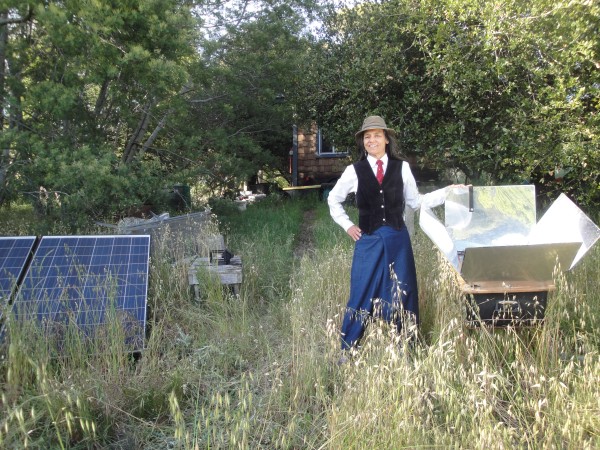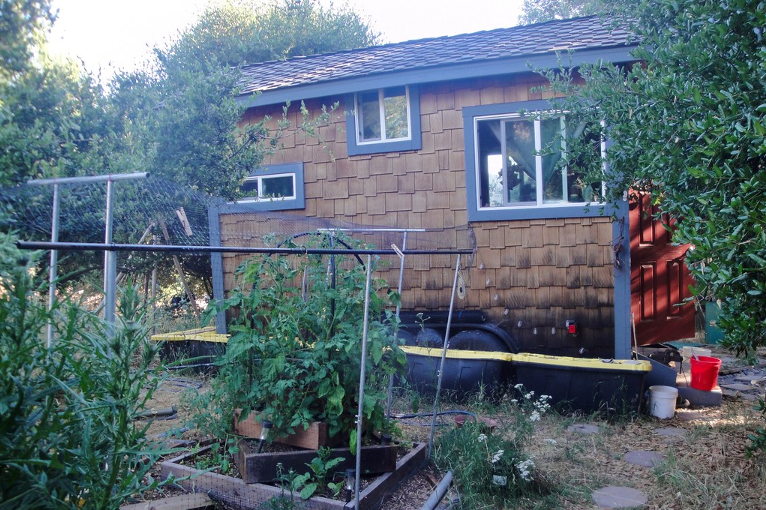I came to the topic of Peak Oil in 2005 at a workshop given by Richard Heinberg in Palo Alto. The information had a profound affect on how I would view the future going forward. My partner and I began to incorporate what I had learned into changes in how we lived, installing solar panels, looking into electric cars and all the standard eco solutions at hand. But more important the information changed how I thought about how the world worked: the economy, our natural resources and most important how we might prepare for a life less dependent on fossil fuels.
Yet I also felt a strange sense of déjà vu. Wasn’t this a story we had already been told? I thought back to the first Earth Day in April of 1970. I was just a kid riding my bicycle to my best friend’s house as we planned to spend summer afternoons riding to Stanford University so we could enjoy the pedestrian-friendly campus and pretend we were students in anticipation of going to college. We had no need of cars; we were proud of our free range adventures by bicycle.
My friend and I made a pact that we wouldn’t get cars when we turned 16 and maybe not until we were adults and were somehow obligated to drive. We joined the Sierra Club and planned on going on a backpacking trip, outfitting ourselves in work boots we found at the thrift store and debating the merits of an army surplus metal canteen versus the tough white plastic bottles that cost a dollar more. I borrowed books from the library to read about hiking the Pacific Coast Trail, mountain climbing and sailing expeditions. I loved reading about the voyage of the Kon-Tiki expedition and the crew of young men who built the ocean-going raft according to ancient plans just to prove it had indeed been possible to make such a journey in such a craft.
When the oil embargo hit in 1973 we smugly didn’t care. We hadn’t even learned to drive yet. We knew about the odd and even days at the pumps and how our parents considered themselves lucky to have license plates of both even and odd numbers on their two cars, and we saw the long lines at the gas stations. There was little fuss about it and we all managed through this cooperative allocation. As immigrants from Europe and Asia, our parents had survived shortages during World War II so they didn’t complain. We were too young to understand how this embargo came about, but on a subconscious level it prepared me to view a future that had limits.
 Amanda with tiny house, solar cooker and solar panels (photo by AK).
Amanda with tiny house, solar cooker and solar panels (photo by AK).
I went off to college with my bicycle, but finding the U.C. Santa Cruz campus too hilly, came home to fetch my unicycle which turned out to be perfect for navigating the wooden pedestrian walkways. When I came to stairs I just hopped off, swung my one wheel up the few stairs, mounted again and continued on my way. I made many new friends, including one who had been raised on a commune in Mendocino. She invited me on a weekend visit to meet her hippie parents who had built a home in the classic style of Buckminster Fuller’s geodesic dome complete with redwood shingles. I was fascinated by this self-styled life of no electricity as my friend showed me how to light an oil lamp. Her father proudly showed off to me his one electric desk lamp and pointed out to me the windmill outside that powered it. In a hot tub heated with a wood burning stove, we soaked with the whole family. My friend told me she got her upper body strength from welding and ax to split the wood for it and indeed she was impressively strong. This back-to-the-land vision made manifest would stay with me for life.
Yet it was not the first time I had experienced such primitive technology. My childhood home in pre-industrialized Thailand barely had electricity and the piped-in city water was so inconsistent that every home had a huge cube shaped water catchment tank that must have been at least two meters to a side. It was filled by the deluge of water coming off the roof during monsoon season. Our house staff used this water to wash our clothes by hand in colorful plastic tubs. I remembered fondly the few nights that the power was out, because my extended family members would leave the one TV and sit outside telling stories.
These episodes of resource limits on a grand scale were thus linked in my mind to warm memories of a home country I missed terribly and a youth coming of age in California as a young immigrant. My father would ask me to help him bleed the brakes on our cars and taught me how to solve mechanical problems. After much struggle, I had proudly learned to fix my own flat tires on my bicycle. I did not consciously choose this future foretold by peak oil. I had fancied for myself a more glamorous profession as a graphic artist, yet when I was introduced to this vision of slow resource depletion it felt curiously like home to me.
After the peak oil workshop I became a devoted follower of an array of intelligent peak oil bloggers on a site called The Energy Bulletin and began to write articles myself as I followed the movement and participated in the shift from sounding the alarm to a more solution-oriented reskilling community as reflected in the name change to Resilience. As a freelance professional organizer I was able to help others organize their homes to become more functional and useful, engaging both my father’s engineer skills as I designed closets and storage spaces, and my mother’s people skills. She had shared with me the behavior modification techniques she was learning to get licensed as a marriage and family therapist.
My life meanwhile continued to depart further from the mainstream. My relationship with my partner came to a natural end and I sought to live entirely off-grid just as the tiny house trend was taking off. I found the tiny house of my dreams on Craigslist, built by two weekend carpenters on a 17-foot trailer. The interior dimensions were so small at 6 by 13 feet that it reminded me of the sailboat my parents and I had sailed every weekend on San Francisco Bay. I remembered how it had been outfitted for sleeping and cooking and had a toilet. All I needed to do was outfit the interior of my new home to my liking. This I proceeded to do from my scrap pile of used doors and an old wooden office workers desk someone had put out on the street by my father’s house.
By the time I had begun to write of my adventures, the pandemic hit and my tiny house and I were put to the test. I found a spot to park the tiny house in a mountain town 40 minutes from my usual Bay Area haunts. During the lockdown, I found information online for doing laundry and other domestic chores. I had no idea there were so many uses for aged urine. I created a garden using water from the water catchment system I designed. My biggest delight was running outside in the morning to see what seeds had sprouted.
As I wrote about off-grid living, I came to see that my maverick style of thinking had its origins in my free-range childhood and coming out as a lesbian within the San Francisco gay liberation movement. Mine was a tale of both personal innovation and the influences of our time. I’d developed sartorial workarounds for navigating tricky social territory and negotiated a male-dominated society during the heady decades of second wave feminism, I’d designed and built my own composting toilet from discarded wine boxes, a funnel and an oil change tank.
During my 17-year encounter with peak oil, I’d learned about soil restoration. Perhaps my curious mission was to fertilize the soil as if I were a cow, and garden the drought-ridden California landscape. Perhaps I could improve the permeability of the land I was seated upon.
Photo: Tiny house and garden. Posted with permission from Amanda Kovattana.





